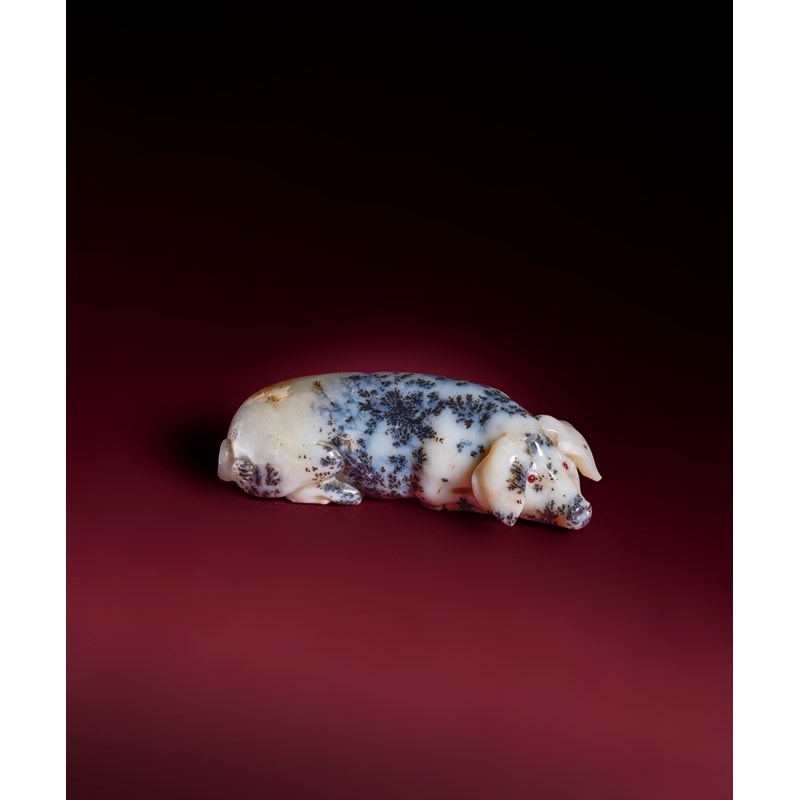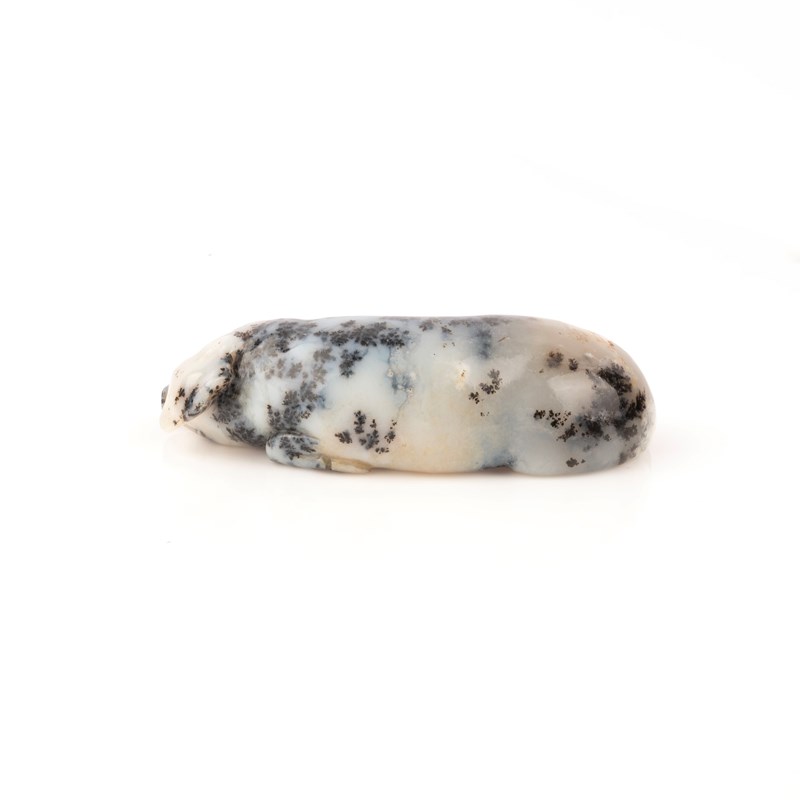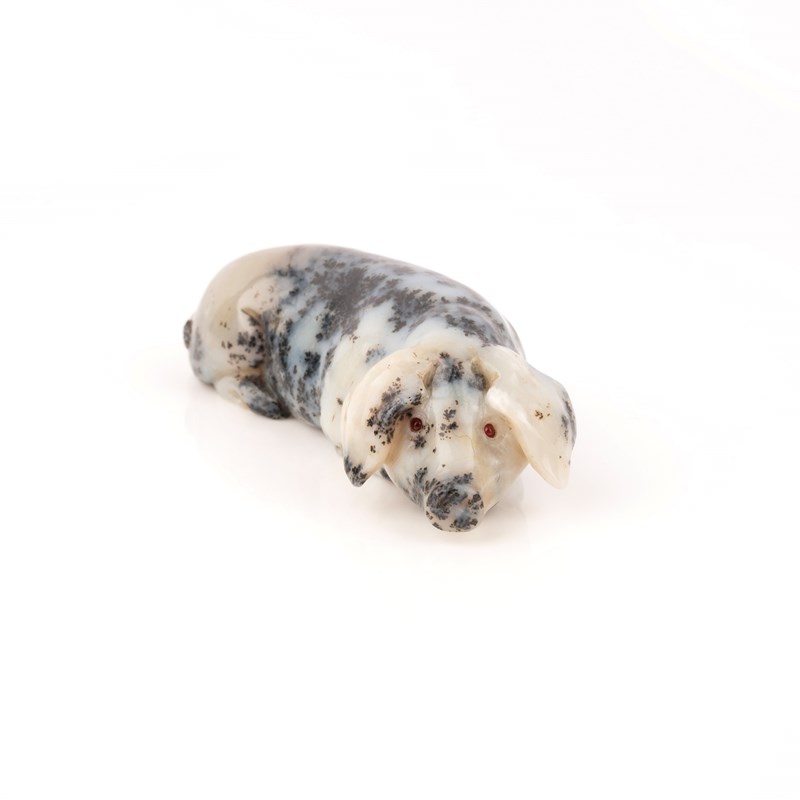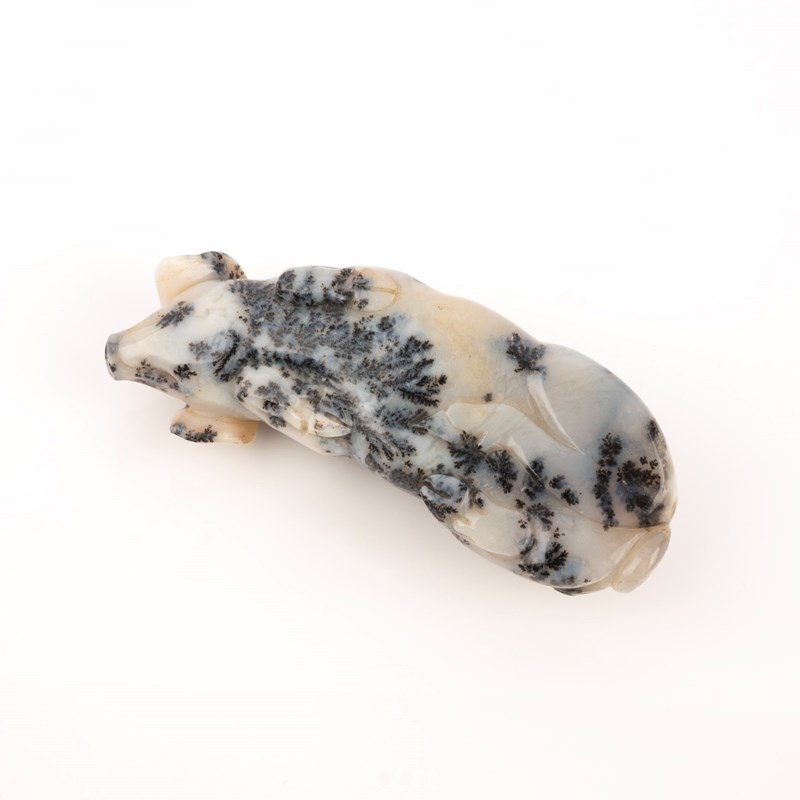435
Fabergé, a dendritic agate miniature animal study, early 20th century, realistically modelled as a reclining Gloucester Old Spot pig, finely carved in dendritic agate, its eyes set with cabochons of red paste, measuring 8.0 x 3.0 x 2.1cm, eyes later replacementsThe quality of this carving and the sensitive treatment of its subject compare favourably with a number of hardstone animal studies produced by the workshops of the Russian imperial jeweller Fabergé. Animal carvings are among the jeweller's most celebrated creations, adored and collected by some of the most prominent figures of the early 20th century. Russia's stone carving industry centred on the city of Yekaterinburg, where Fabergé acquired the workshop of lapidary Karl Woerffels around 1884, and it was this workshop that produced the majority of them - the carvers Kremlev, Derbyshev and Svetchnikov, managed by the German Alexander Meier. The stones were carefully selected by Carl Fabergé's son Agathon, and were mostly of Russian origin, taking advantage of the rich mineral resources of the Ural mountains and Siberia. The animal carvings found immense popularity with a number of the firm's key patrons, most notably the British Royal Family, whose collection boasts more than 350 animals, and Léopold de Rothschild, who had his racehorses similarly immortalised by Fabergé's sculptors.The dendritic or 'moss' agate used here is an unusual choice for an animal study, its distinctive patterning more commonly employed by Fabergé for inlays and panels in its jewels and objets de vertu. Traditionally found in India but eventually sourced by Fabergé from Siberia, its use here is likely a clever attempt to mimic the distinct patternings of a particular breed of pig known as the Gloucester Old Spot, whose 'lop' ears are also distinctively forward folding as in the present carving, partially shielding its eyes. A number of realistically modelled farm animals including pigs were produced from life at the Sandringham estate in 1907, following a suggestion made to King Edward VII by Fabergé's London agent Henry Bainbridge that the firm recreate a number of the animals across the estate. With subjects ranging from the King's own terrier dog Caesar, to the cows, pigs, ducks and chickens that populated the farmland around them, the animals of this 'Sandringham Commission' were reproduced in wax sculptures by the carver Boris Frödman-Cluzel, before being sent back to the Russian workshops to be immortalised in hardstone. They were then sent back to Fabergé's London branch for purchase, mostly, but not exclusively, by those who wished to gift them back to the Royal Family. Such was the appeal that some were even acquired by members of the family themselves, such as Princess Victoria, who bought a model of a recumbent white sow in pale pink aventurine quartz in 1912 (RCIN 40041). It is not known whether the present study would have been part of the Sandringham commission, but the close attention to detail and the choice of this lesser known breed of pig reflect a close observation of the animal, likely in its agricultural setting, and a desire by the sculptor to capture the distinctive characteristics of this specific breed. King Edward VII was particularly proud of his pigs and sent the best of his herd to The Royal Society Show in June 1911. Pigs were one of Fabergé's more popular animal studies in their native Russia, with several examples recorded in the collection of Empress Maria Feodorovna, and are also among the most humorous and varied of their miniature sculptures.Cf.: a series of carved hardstone pigs by Fabergé in the Royal Collection, collection nos. RCIN 40041, 40038, 40421 and 40422, commissioned by the Royal Family and studied by Fabergé's sculptor Boris Frödman-Cluzel from life at the Sandringham estate in 1907.Cf.: The Robert Strauss Collection of Works of Art by Fabergé, Christie's, 9th March 1976, lot 28, and A. Kenneth Snowman, The Art of Carl Fabergé, 1972, no.237, for







 Live online bidding is available via our own
Live online bidding is available via our own